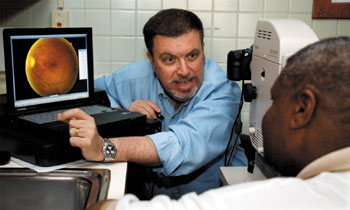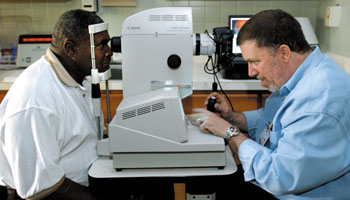
Larry Merin shows Meharry patient Thomas Harrison a photograph of his retina taken with the revised camera equipment. (photo by Dana Johnson)
Eye on prevention – Technology, Alliance, grant focus e

Harrison sits while Merin takes a photograph of his retina. According to Merin, the pictures are worth a thousand patient education sessions. (photo by Dana Johnson)
Larry Merin explains the relevance of his project – halting the slow progression of diabetic retinopathy, the leading, yet often preventable cause of blindness among U.S. adults – with passion befitting a crusader.
“I just got tired of it,” he said. “If we’d reached these people before catastrophe knocked on their doors, they could look their children in the face, they could work, they could be productive members of society…It doesn’t have to be this way.”
Thanks to Merin’s ingenuity and expertise with optical technology, many Nashvillians are being reached in time through a pioneering screening effort. Merin, assistant professor of Ophthalmology and director of Ophthalmic Imaging at Vanderbilt, is one of the first in the United States to combine information technology, retina photography, digital imaging and telemedicine for the detection of retinopathy – all in a primary care setting. A new grant by the HCA Foundation will put his hybrid technology in community health clinics on Nashville’s east and west sides by 2002.
Many people in underserved or minority population groups do not receive recommended annual retinal screenings for a variety of reasons, said Dr. Kristy F. Woods, professor of Medicine at Meharry and Vanderbilt and director of the Rippel project. “The fundoscopic imaging technology allows for the screening to be done at the site of the primary care encounter. We’ve increased the yield of fundoscopic screening significantly and picked up a lot of pathology.”
“Larry Merin and the ophthalmology folks are helping us improve the quality of eye care for patients with diabetes who need it and can’t afford it – in inner-city Nashville, that’s 6,000 to 8,000 patients,” said Cathy Taylor, MSN, assistant professor at the Vanderbilt University School of Nursing, director of Disease Management for the Meharry-Vanderbilt Alliance and principal investigator of the HCA grant. The grant money will supply equipment and personnel for permanent screening sites at two federally qualified community health centers – United Neighborhood’s Casey Clinic and the Matthew Walker Clinic.
Eventually, the equipment can be set up in rural clinics and, with telemedicine capabilities, the images wired back to Vanderbilt, where they will be reviewed in a couple of days. “This really fits in with our strong belief in preventive ophthalmology,” said Dr. Denis M. O’Day, George Weeks Hale Professor and chair of Ophthalmology and Visual Sciences.
Diabetic retinopathy, damage to the blood vessels that supply the retina, can be prevented, or reduced, with effective overall diabetes management, O’Day said. But regular screenings to catch it early are essential. Every diabetic in the nation should be screened. “We now have the technology to do that,” he said. Once detected, sight-threatening changes can be treated by laser, a therapy proven to reduce visual loss if applied early.
In a darkened 8-by-10 room off a quiet Meharry Medical School corridor, Merin, who O’Day and others refer to in missionary terms, runs a pilot project that’s proved the project worthy as part of the comprehensive Rippel Diabetes Project. He sits behind his creation – a standard retinal fundus camera that looks at the back of the eye, with a non-standard twist, a Canon digital camera screwed on the back, linked to a laptop.
Within seconds, Merin photographs patients’ retinas and displays them on the computer’s screen. If retinopathy has begun the normal streams of blood vessels appear as flooded waterways, or spots show leakage points. The pictures, Merin said, are worth a thousand patient education sessions.
“It’s empowering,” Merin said. “A lot of these people are asymptomatic, when in fact they have things going on which are observable through the technology we use. We’re able to show patients images of their own eyes on the screen and it becomes pretty compelling evidence. They suddenly sit up and pay attention.”
Thomas Harrison, a Meharry patient, said he took his diabetes for granted until his blood sugar plummeted and he wound up in a hospital. Since then he is well aware of the damages of diabetes, even to his eyes. But he didn’t know there was a spot of blood on his left retina, dangerously close to the macula, the focal point of the eye.
“This is a situation I didn’t know anything about, and it could have been worse,” said Harrison, a semi-retired auto mechanic. “Now it’s something I can watch out for.”
Merin brings the photos back to Vanderbilt for review by Dr. Juli Dean, assistant professor of Ophthalmology with appointments at Vanderbilt and Meharry, further developing both the technology and the Alliance. The process, Merin said, “raises the roof on the level of care and simultaneously changes the care network from a bungalow to a large warehouse. We not only do a better job, we treat more people.”
Merin’s camera uses a Canon camera from Japan and Eye Q software from England, where programs like his have been in place for several years. Gerry Skews, director for Eye Q developer Digital Healthcare Limited, said Merin’s work is “trailblazing” in the U.S. Eventually, Merin said, the screening technology can be mobilized to reach more people throughout Middle Tennessee, and discussions are underway with telecommunications companies to facilitate a broader reach.
Taylor said the screening has potential to become part of a nationwide model for improved management of diabetes particularly for high-risk groups or in rural areas where access to specialty care may be limited.
Merin thinks it’s about time screening became universally available for those who need it. “It’s a beautiful thing,” he said.













